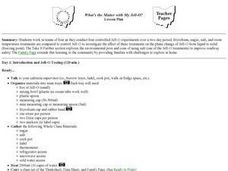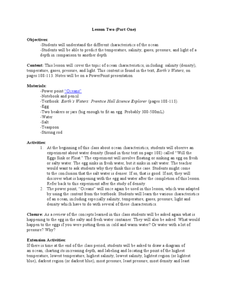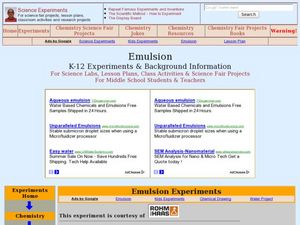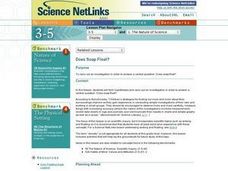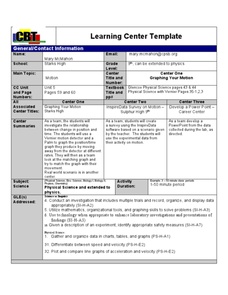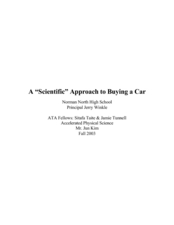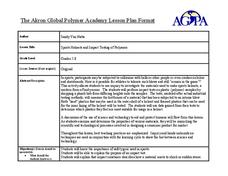Curated OER
What Floats Your Boat?
Students discover the Archimedes principle through a buoyancy experiment. They measure the water displacement of a lump a clay which is denser than water then reshape the clay into a bowl which floats but displaces more water.
Curated OER
Changes Inside Planets
Students investigate the concept of planetary differentiation. They complete an experiment to simulate it using gelatin and food. The lesson includes vocabulary to increase reading comprehension skills as part of the inquiry. The lesson...
Curated OER
Bell Live! The Great Lakes: A Superior Adventure
Students participate in a virtual field trip to Lake Superior. In groups, they perform experiments in which test the level of toxins and bacteria in the water. They also watch video segments life in the lake and discuss their observations.
Curated OER
Earth History Part II
Eighth graders hypothesize what caused the break up of continents. In this earth science lesson plan, 8th graders study about the events that took place during Mesozoic and Cenozoic Era. They reconstruct a supercontinent and report their...
Curated OER
Emulsion_ Compulsion
Students experiment with common household products to determine the properties of emulsions and how they fit into the classifications of matter through this series of lessons.
Curated OER
What's the Matter with My Jell-o?
Students work in teams of four as they conduct four controlled Jell-O experiments over a two-day period. The Family Page extends this learning to the community by providing families with challenges to explore at home.
Curated OER
Not a Drop to Drink
Pupils design an experiment to determine which liquid is water. In this chemistry instructional activity, students perform the experiment as outlined in their design. They record observation and formulate conclusion.
Curated OER
Thermo and Fluid Dynamics of a Homemade "Lava Lamp"
Students construct their own lava lamp using simple substances. In this physics lesson, students explain how difference in density causes convection. They solve for forces and buoyancy using mathematical equations.
Curated OER
The Sun as the Driving Force of the Water Cycle
Students study the water cycle and how the sun is an important factor. For this water cycle lesson students investigate how to desalinate water and explore the different densities of fresh versus saltwater.
Curated OER
What's Matter?
Students explore many of the basic properties of matter including atoms, ions, elements, molecules, and density. The class explores an interactive flash-animated Web site to answer questions and clarify misconceptions they might have had...
Curated OER
Lesson tow
Students study the ocean and its characteristics. For this oceans lesson students complete a lab activity and are able to predict temperature of certain depths.
Curated OER
Force and Motion - Part 2
Students test different objects such as dominoes, marshmallows, slides, and more to test their force, motion, gravity, friction, and the concept of matter. In this force and motion lesson plan, students understand that the force an...
Curated OER
The Influence of Carbon Dioxide on the Chemistry of Soda
Students investigate the carbon dioxide content of different sodas. In this chemistry activity, students explain why PET containers are preferable than HDPE for soda bottles. They collect data and graph them.
Curated OER
Deep Thoughts
Students examine what lies within the Earth. They research and create scale models illustrating the layers of the Earth and write skits advocating a travel plan to send a probe into the Earth's mantle.
Curated OER
It's a Gas - Natural Gas
Students use plastic bottles, water, and condiment packets to simulate how natural gas comes from decaying ocean plants and animals. In this natural gas lesson plan, students also fill out lab packets and answer exit questions.
Curated OER
Emulsions
Learners identify the characteristics and composition of emulsions. In this chemistry lesson, students classify household products according to emulsion type. They explain how to make the best emulsion.
Curated OER
Does Soap Float?
Students form hypotheses and carry out an investigation in order to answer a central question: Does soap float? The focus of this lesson is on scientific inquiry, but it incorporates scientific topics such as sinking and floating.
Curated OER
"Graphing Your Motion"
Students study the concepts of motion, velocity, and acceleration through graphing their own movement using LoggerPro. They explain the difference between speed and velocity using the weather vane example. They discover the difference...
Curated OER
Animal Science Research Report
Students research an animal. In this research instructional activity, students utilize various types of technology to gather information about an animal. Students create a class blog and use digital photography for their research.
Curated OER
A “Scientific” Approach to Buying a Car
Students examine what it takes to purchase a car and the resources out there to help find what you are looking for. In this scientific method lesson students complete different problem solving situations.
Curated OER
Introduction to Scientific Method
Students investigate safe laboratory procedures, classroom management guidelines, and group roles and procedures. They study a set of safety guidelines with their parents, and to sign a contract stating that they understand the...
Curated OER
I've Got That Sinking Feeling
Middle schoolers design a simple boat and predict how much weight it can carry. They should also discover why objects float or sink and how this can be determined experimentally. A great lesson on buoyancy!
Curated OER
Sports Helmets and Impact Testing of Polymers
Learners examine the importance of good quality safety gear. In this investigative activity, students will tests various polymers, collect data, and analyze the data to determine which polymer is best for safety helmets. They will design...
Curated OER
Habitat Art: Florida Panthers
Students discover the lifestyles of a Florida Panther by investigating its habitat. In this wild animal instructional activity, students utilize the Internet to research the habits of a Panther and what their habitat is....





